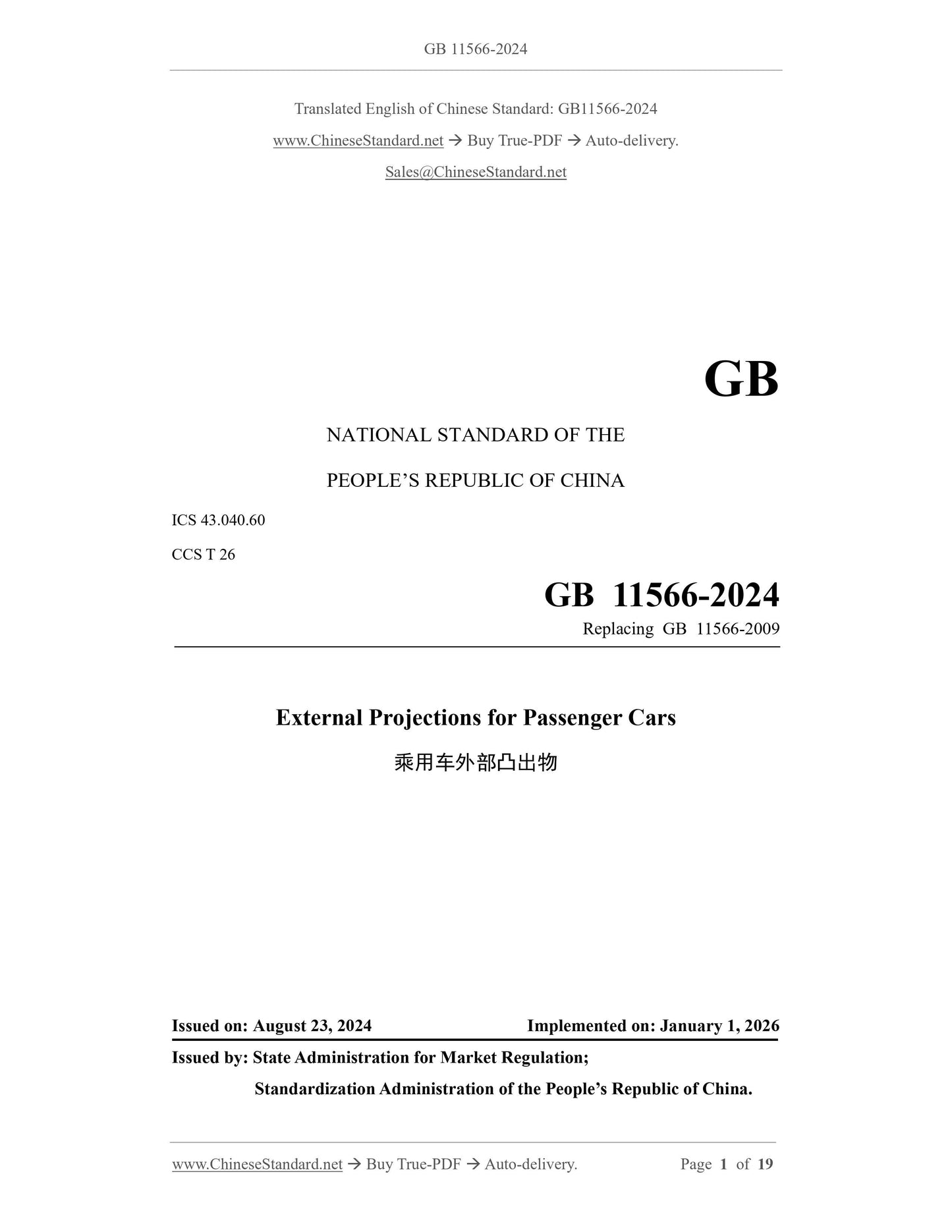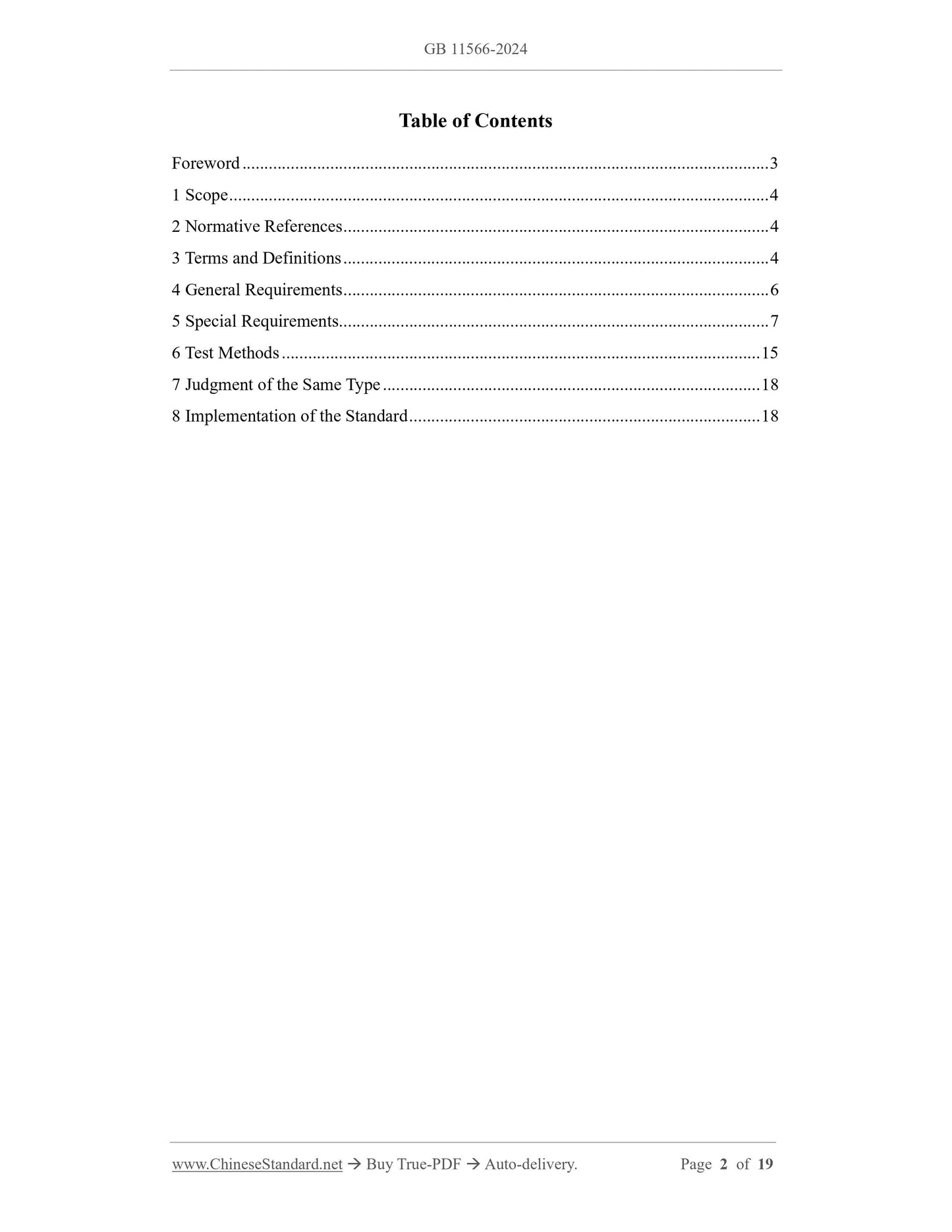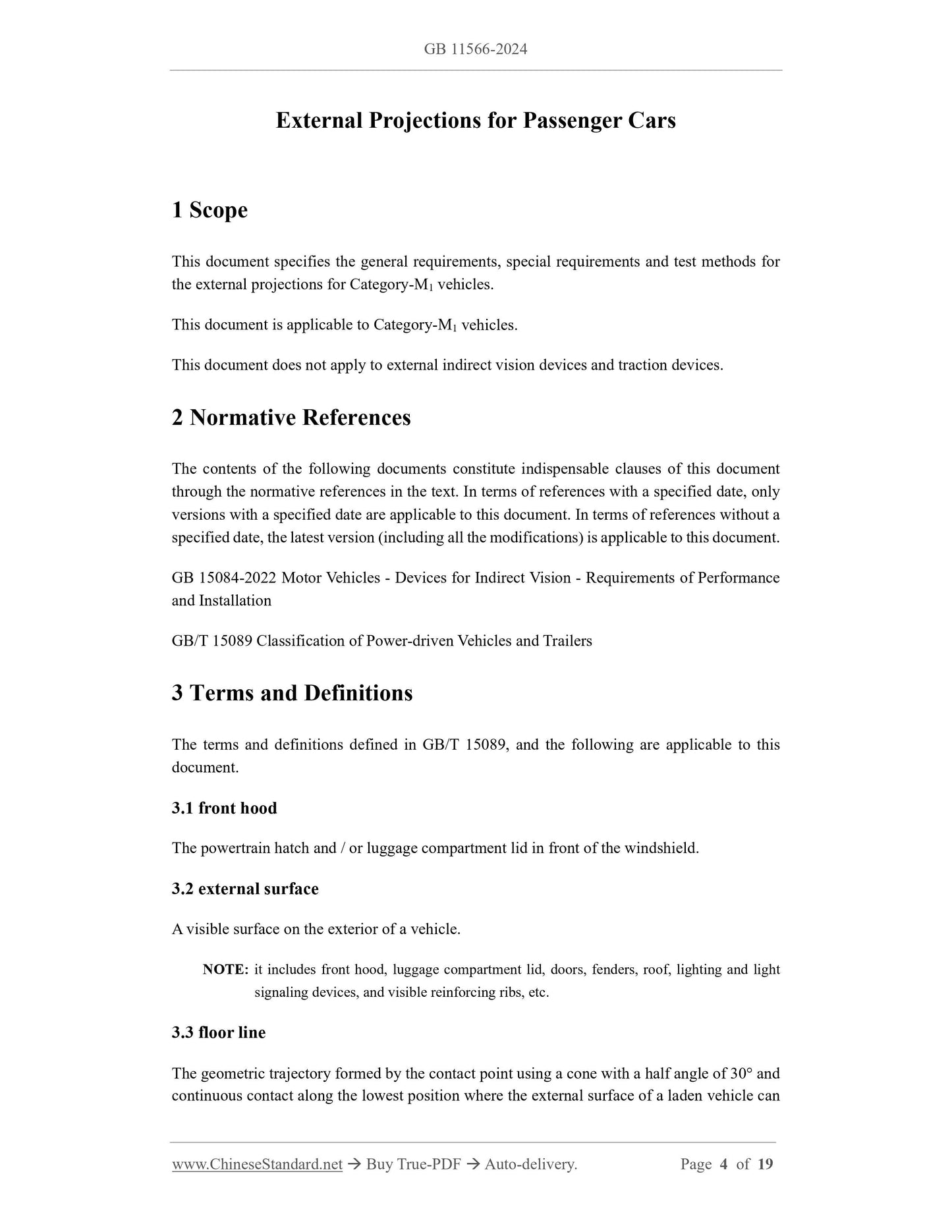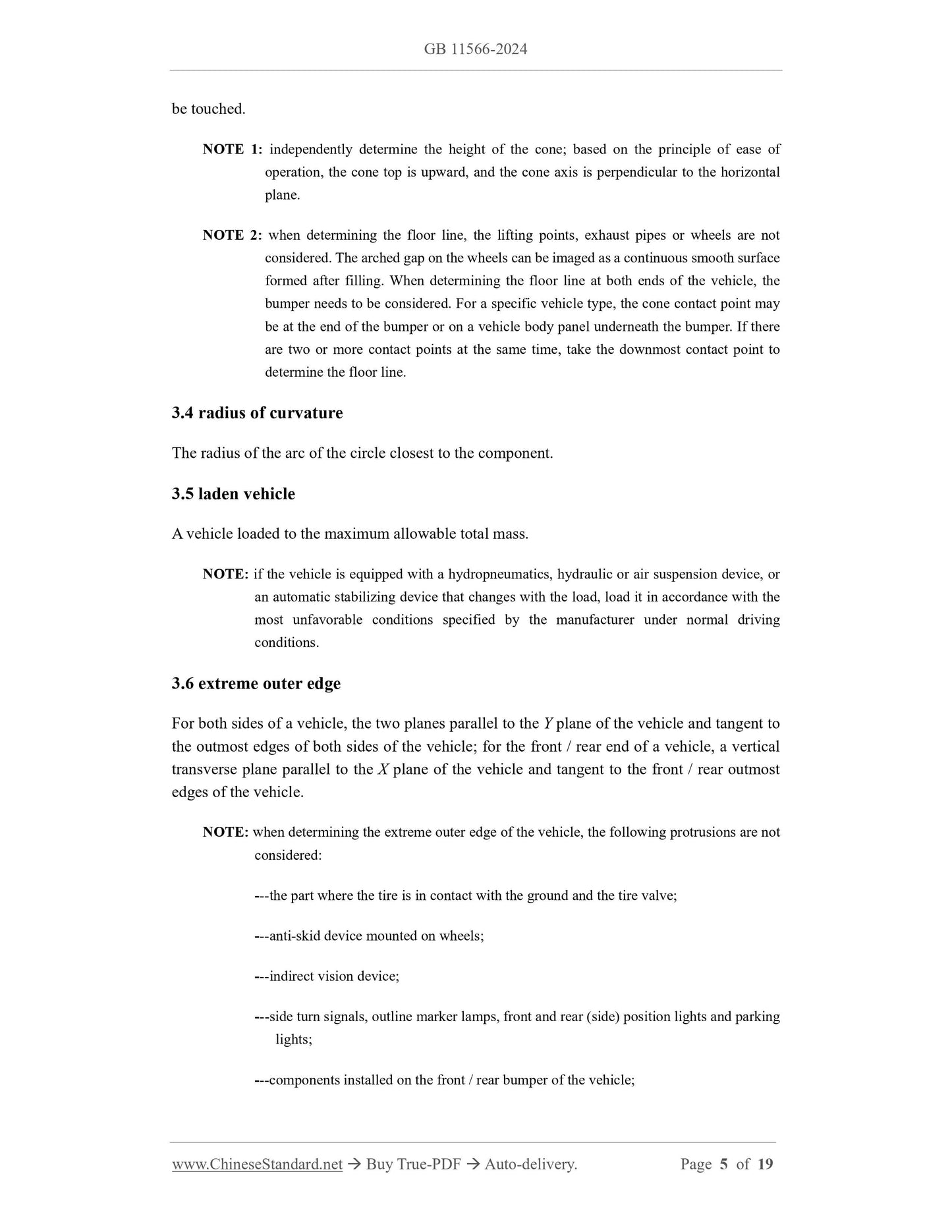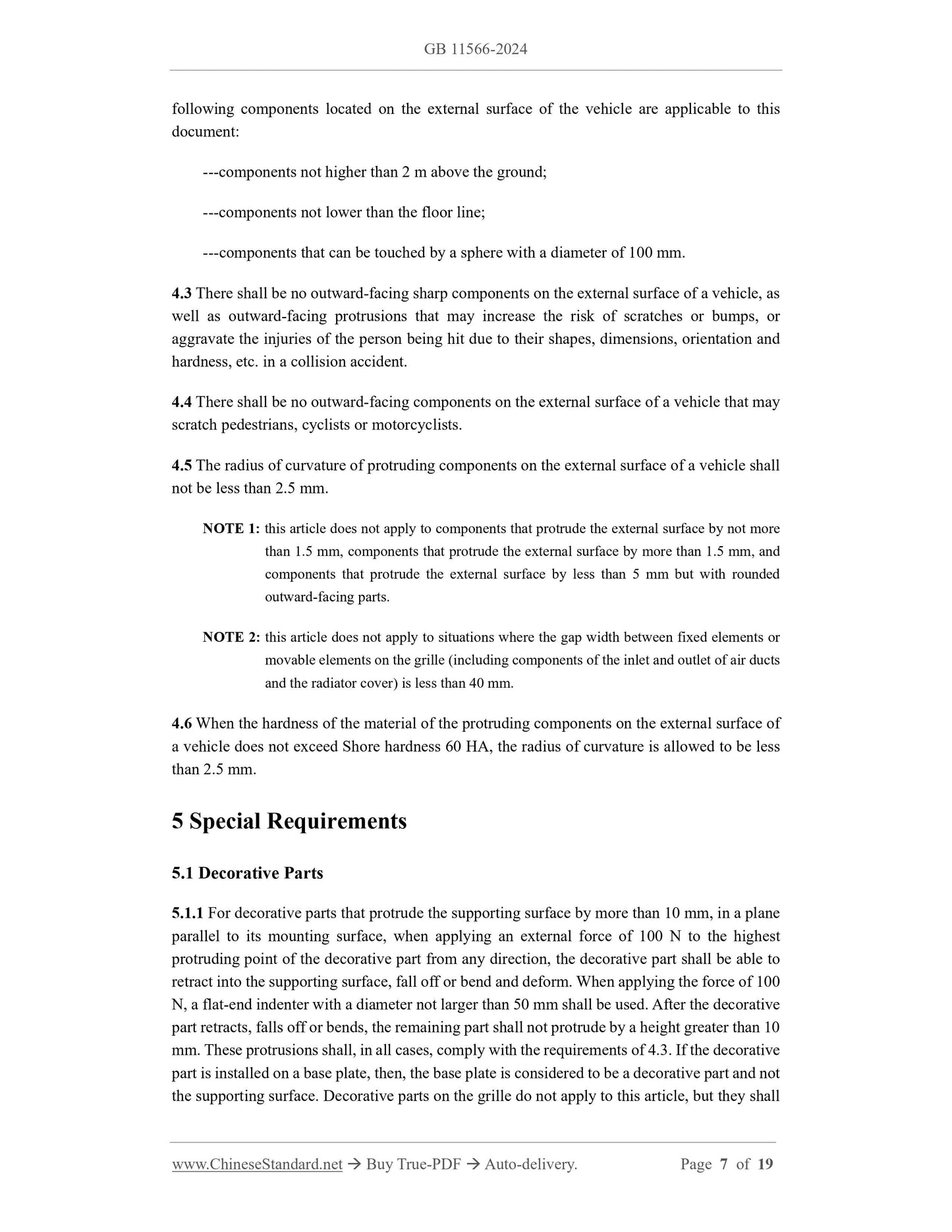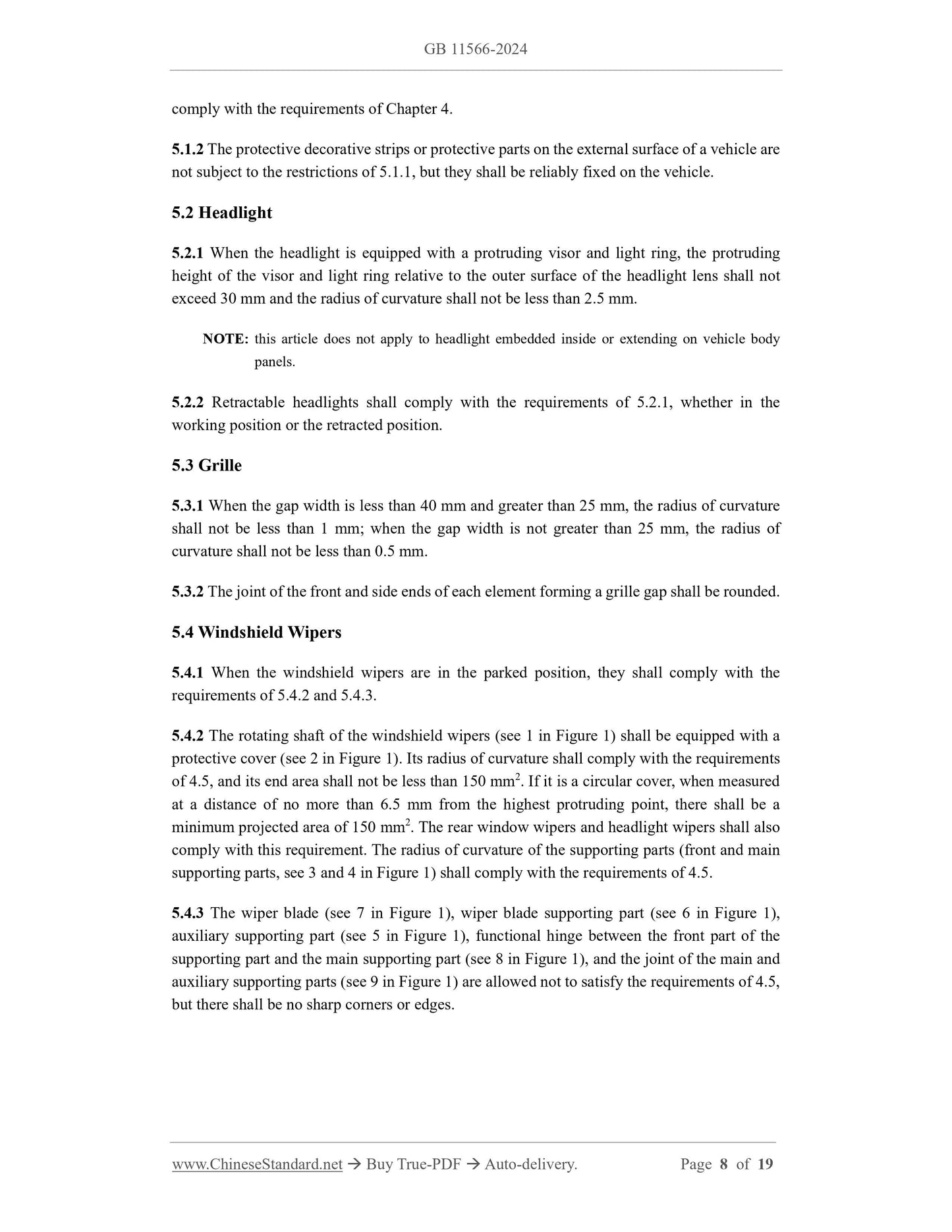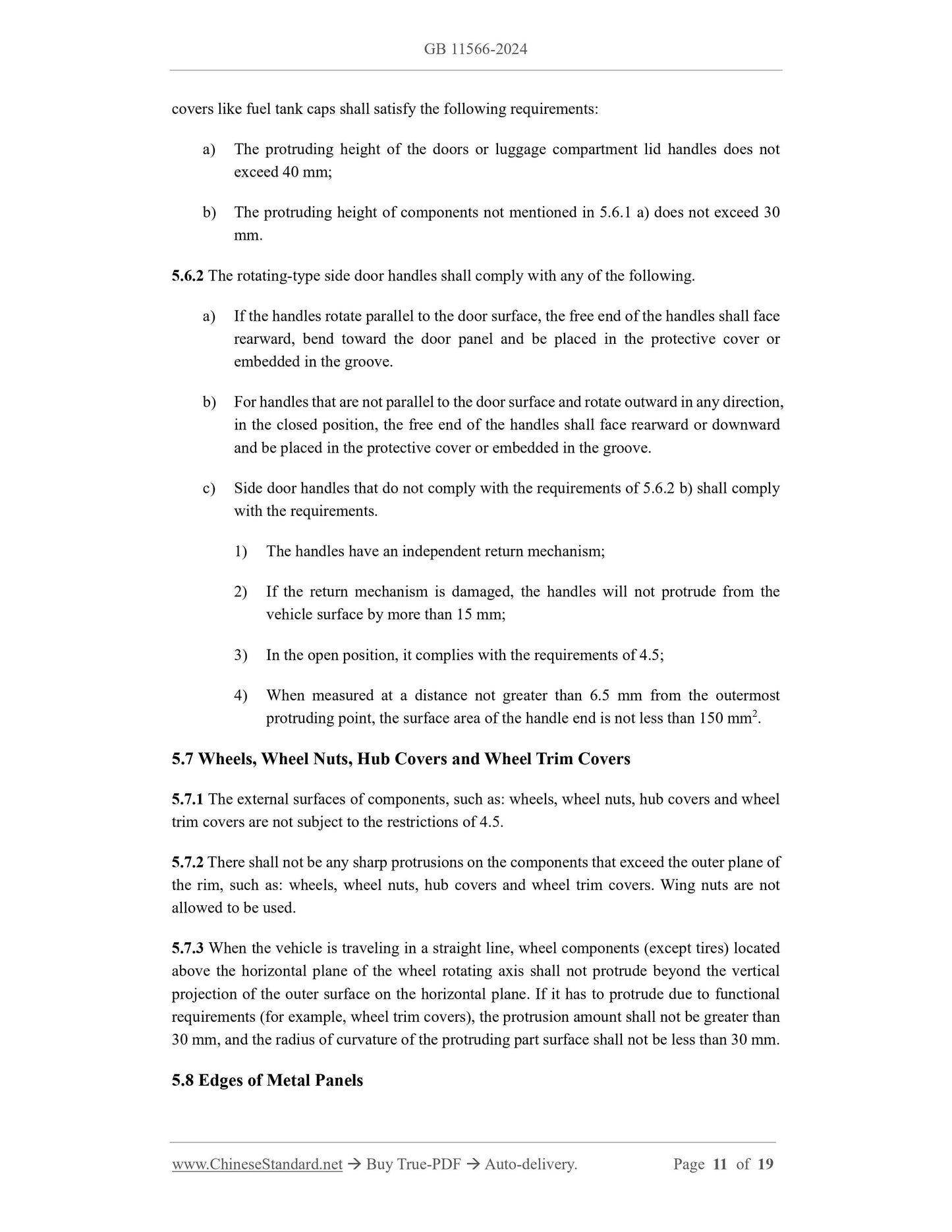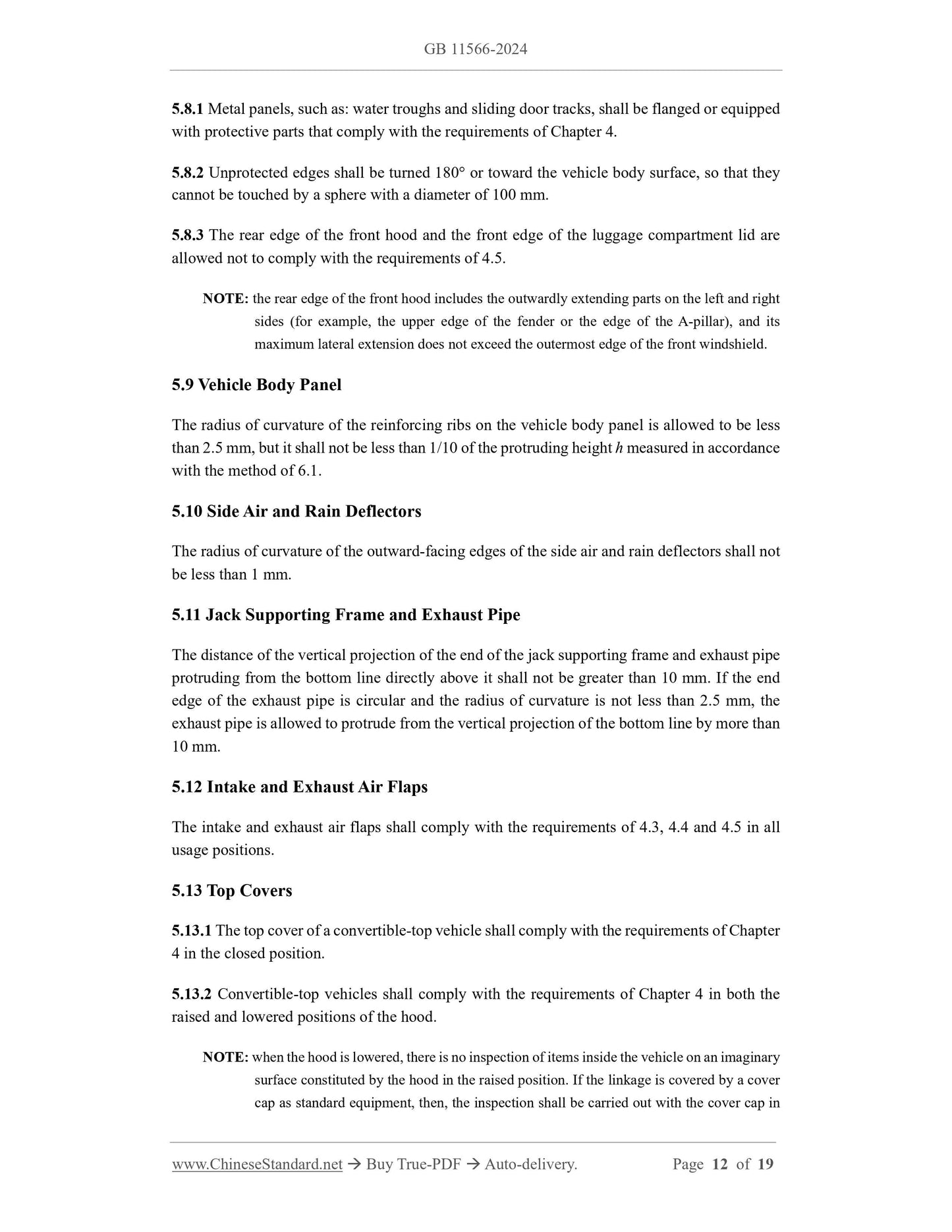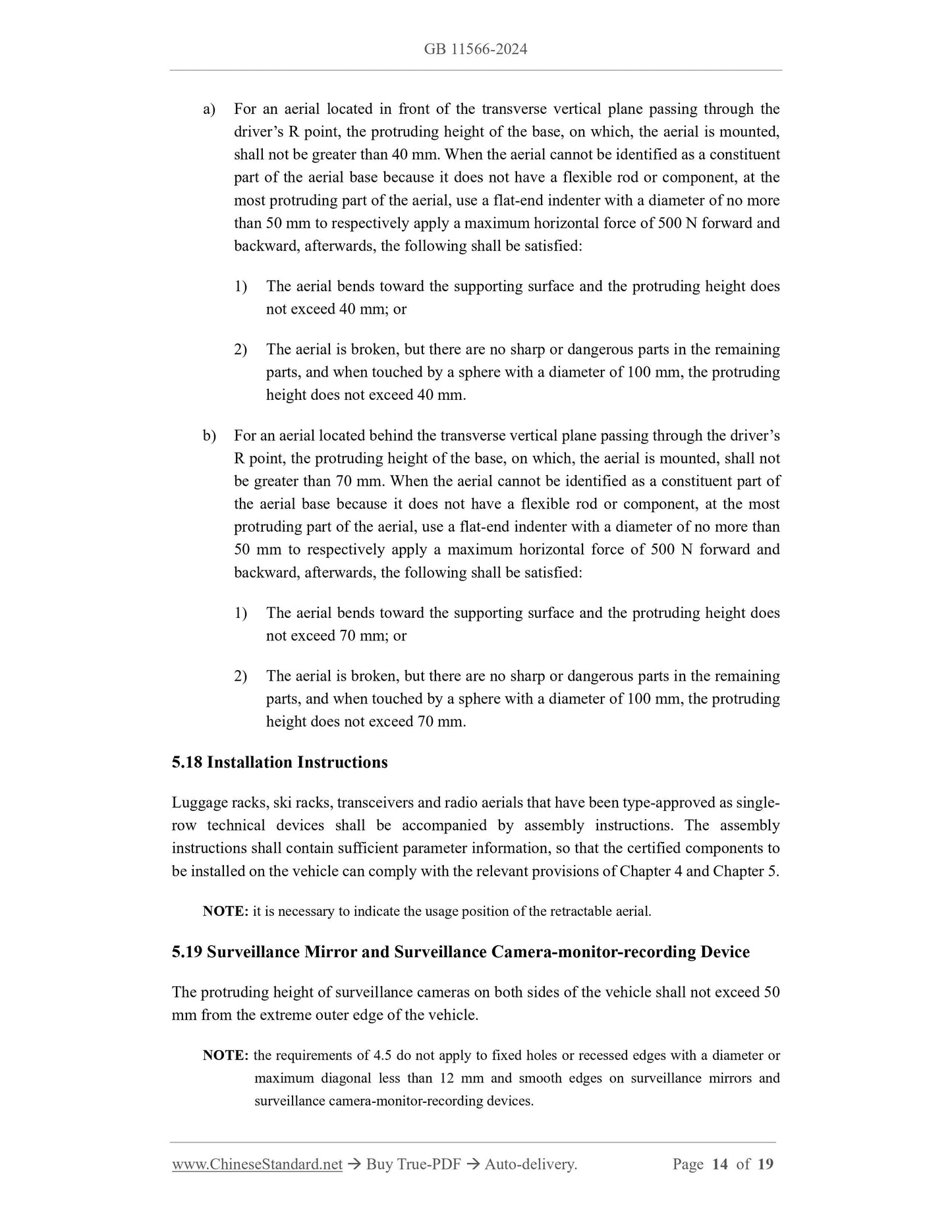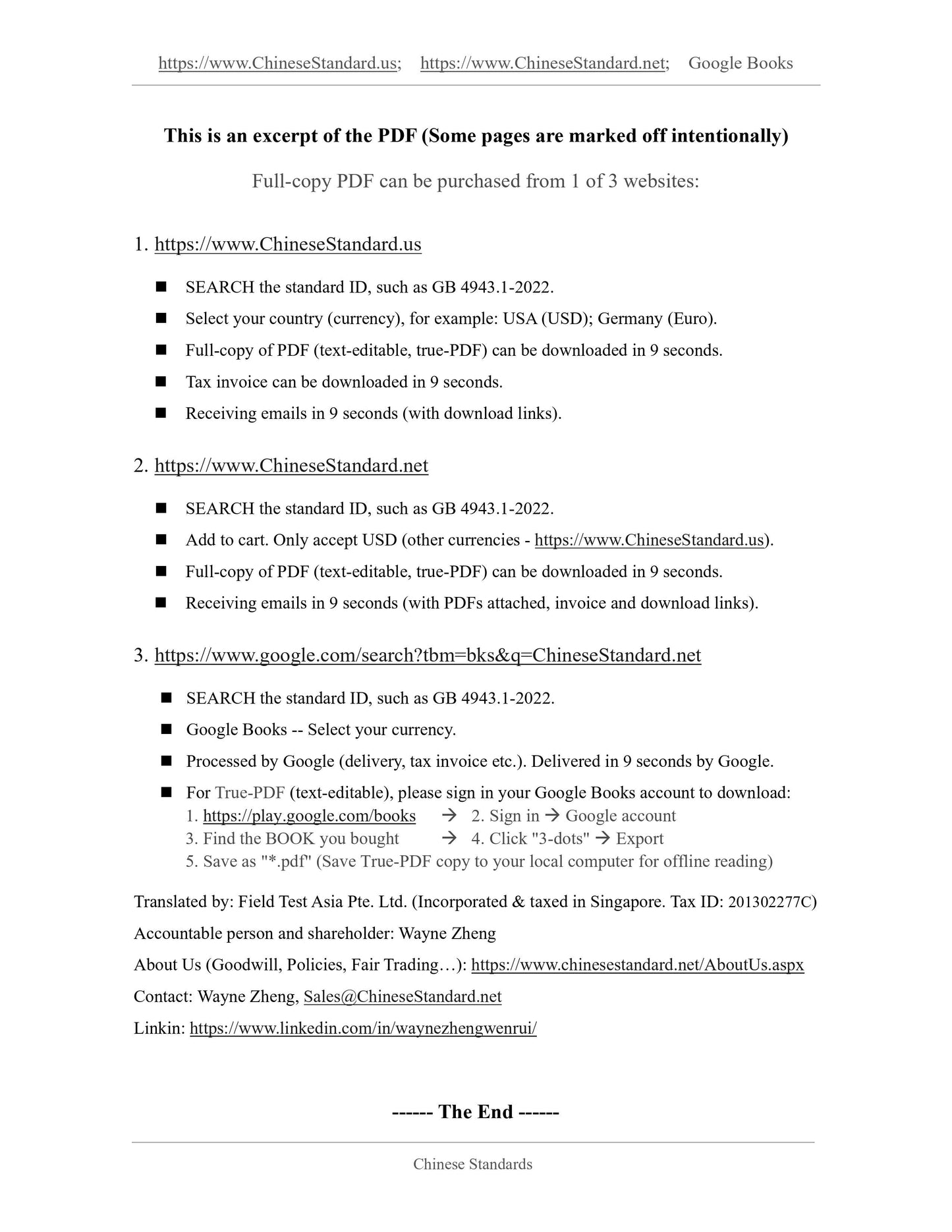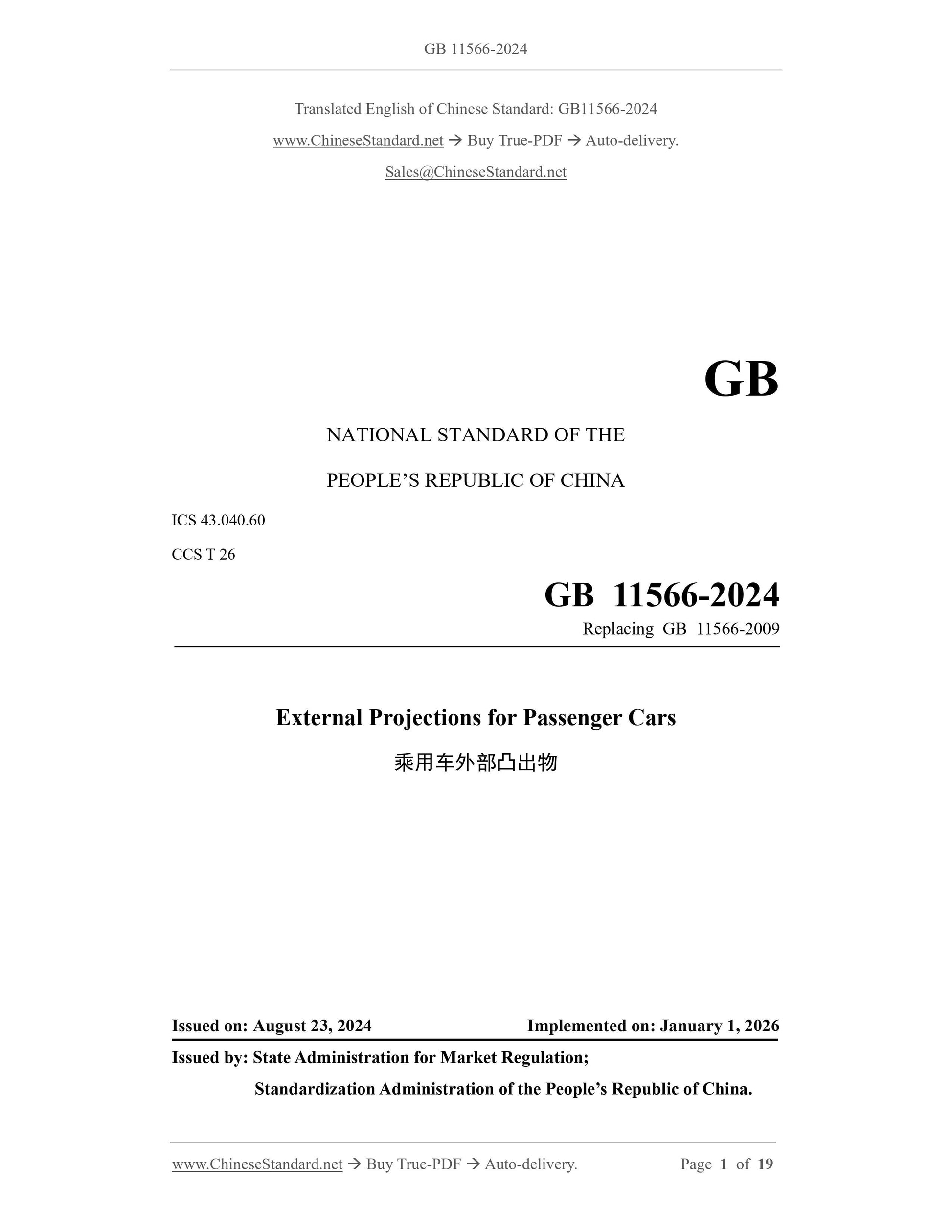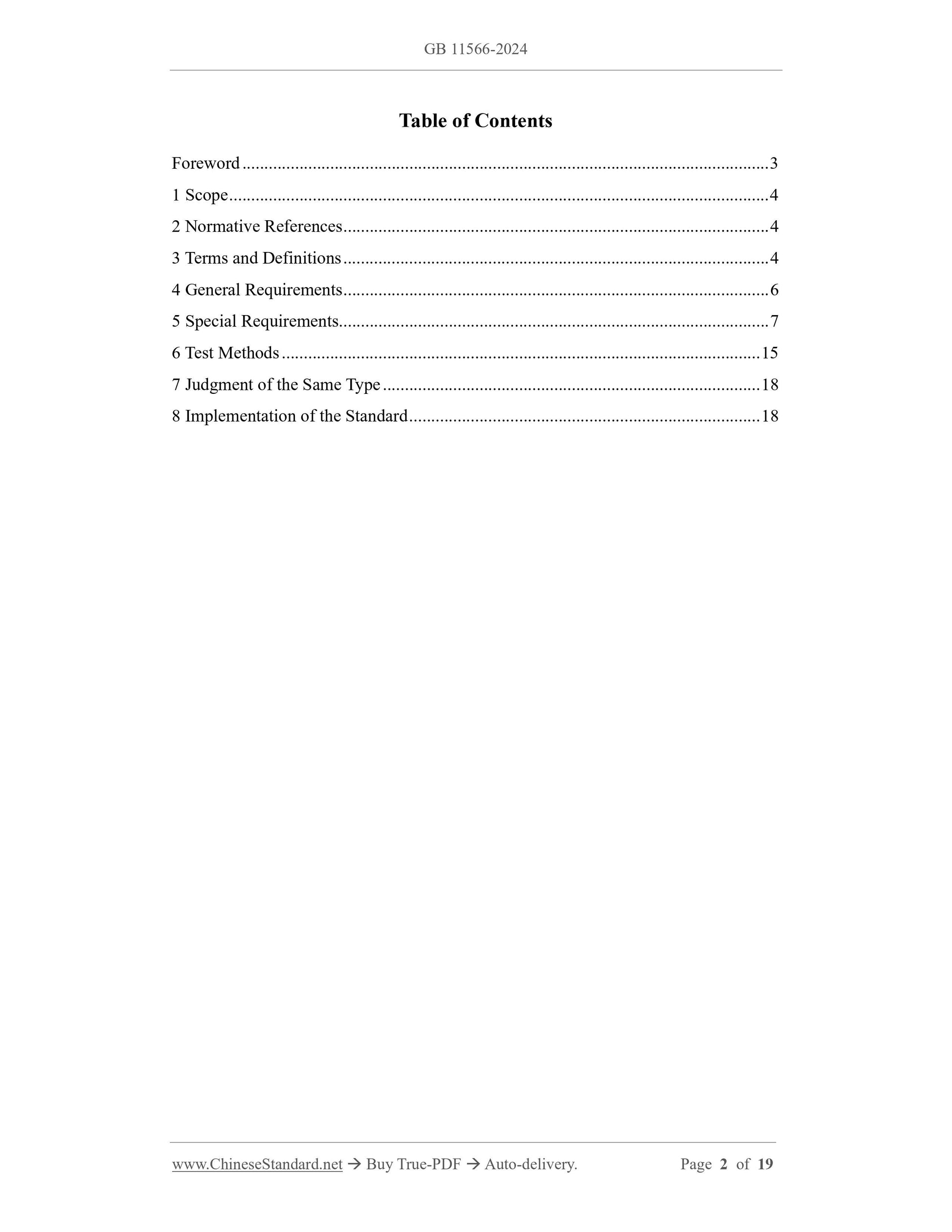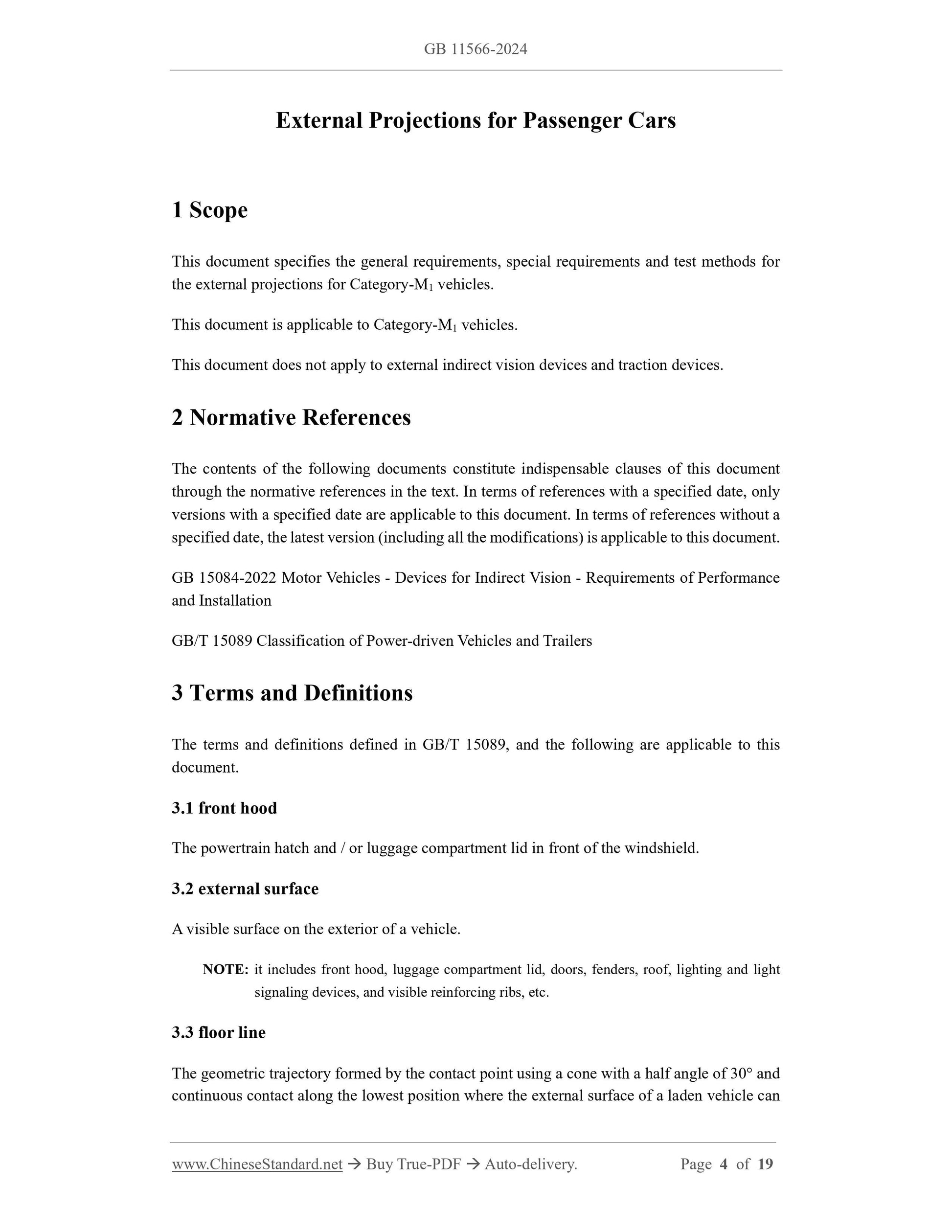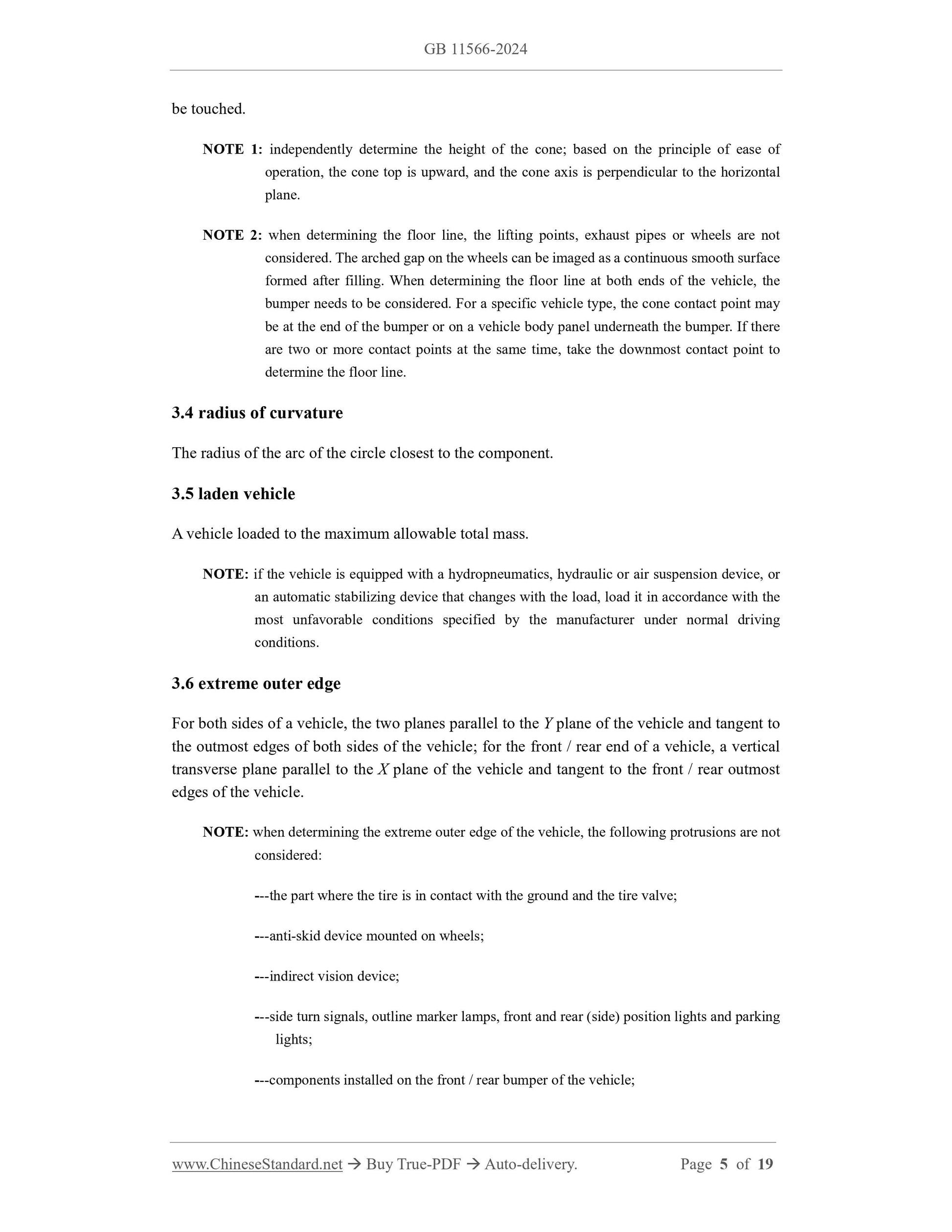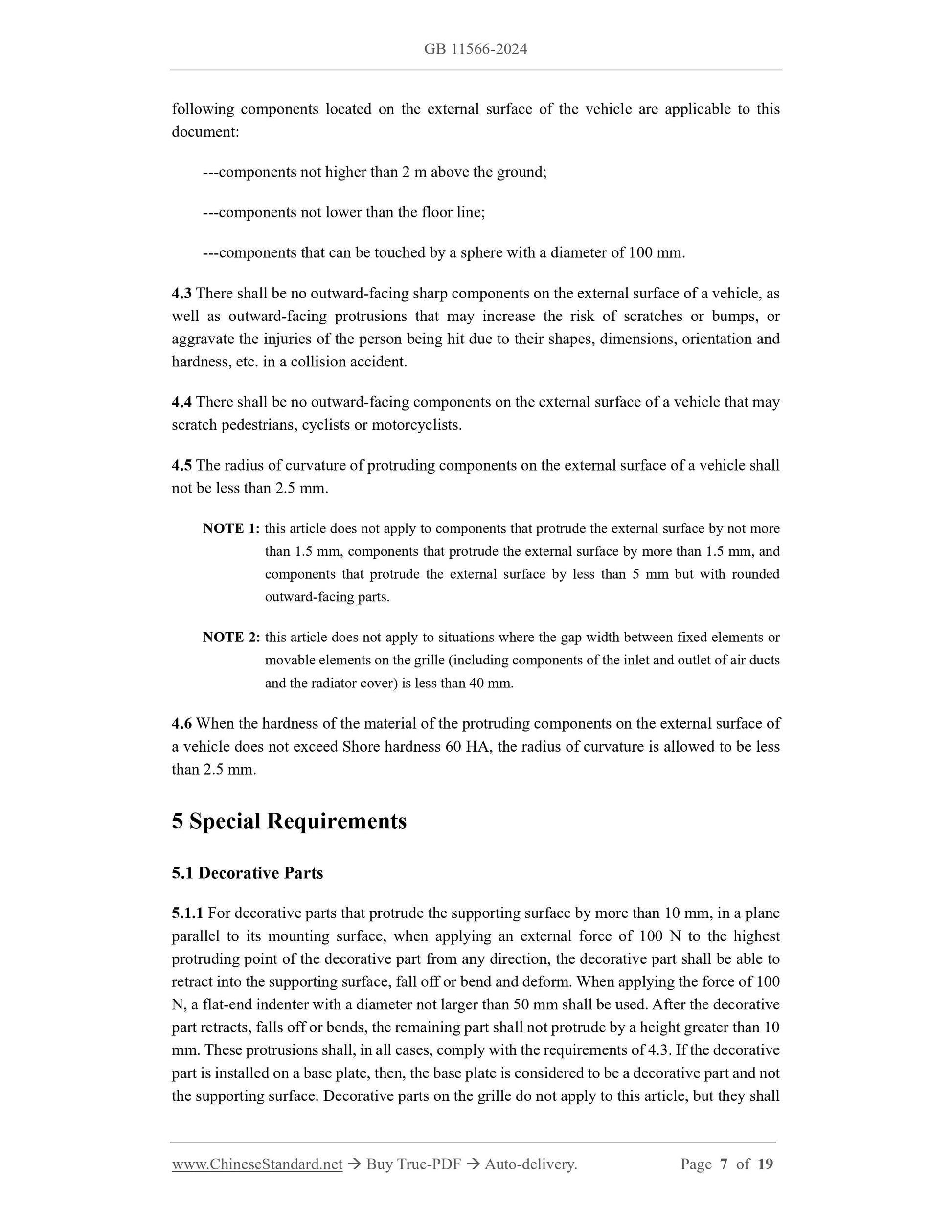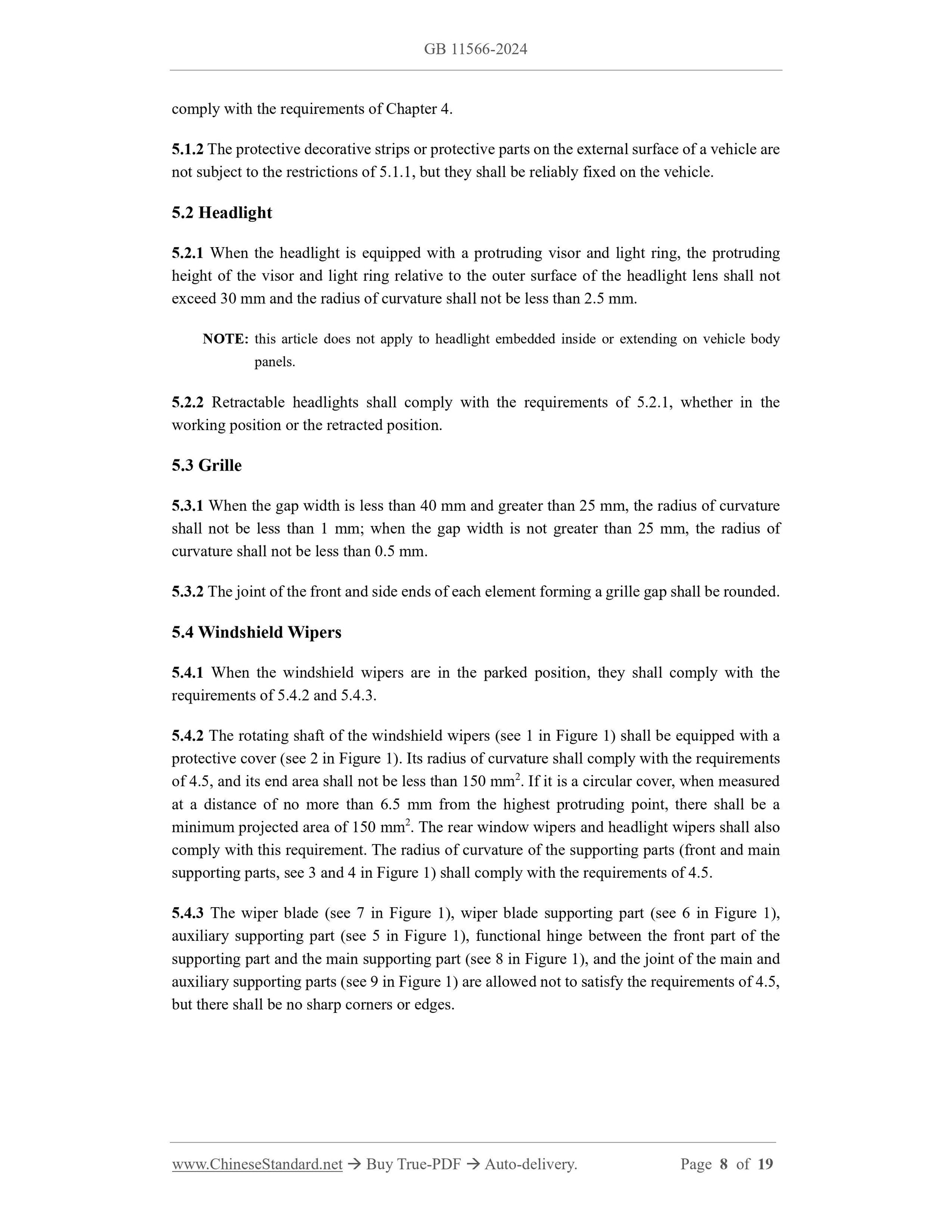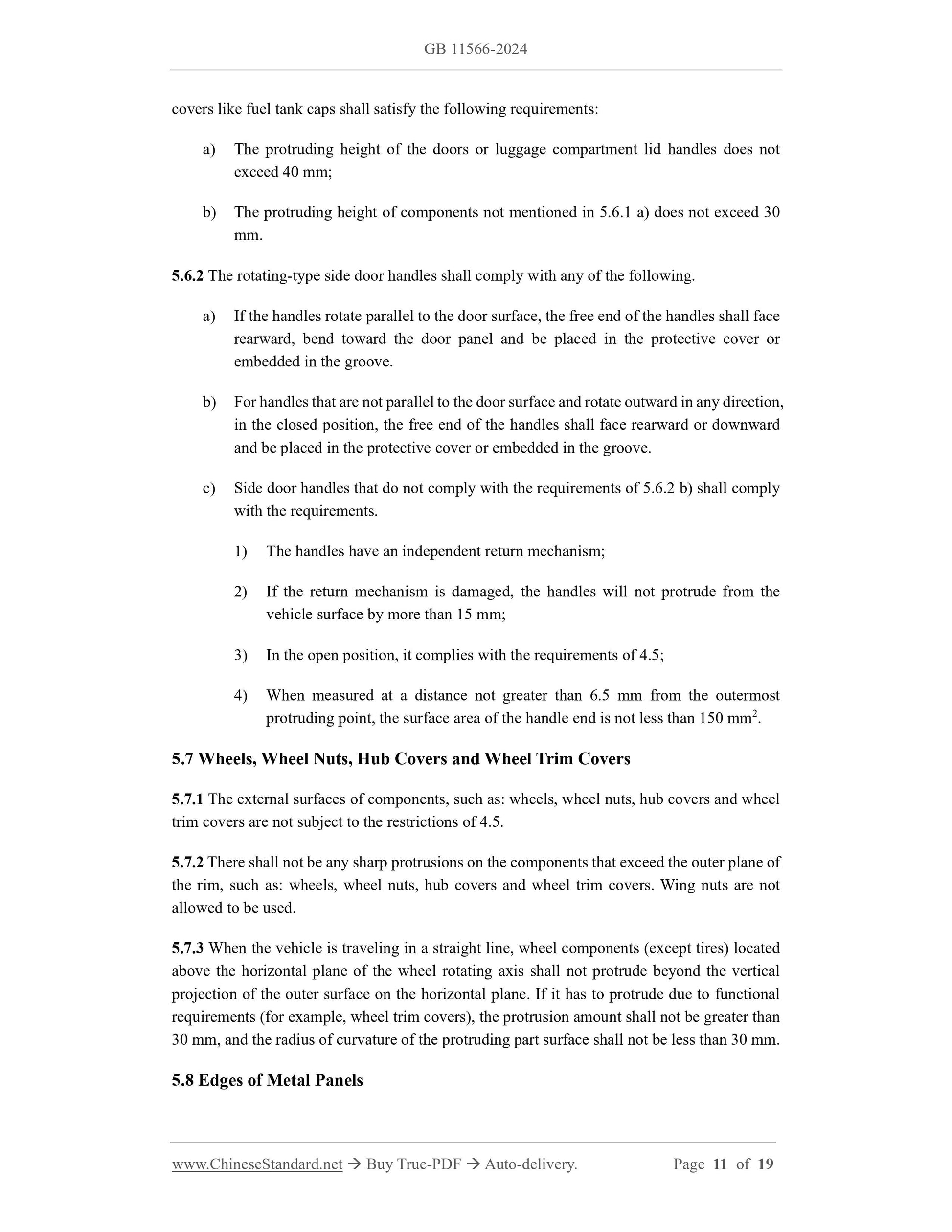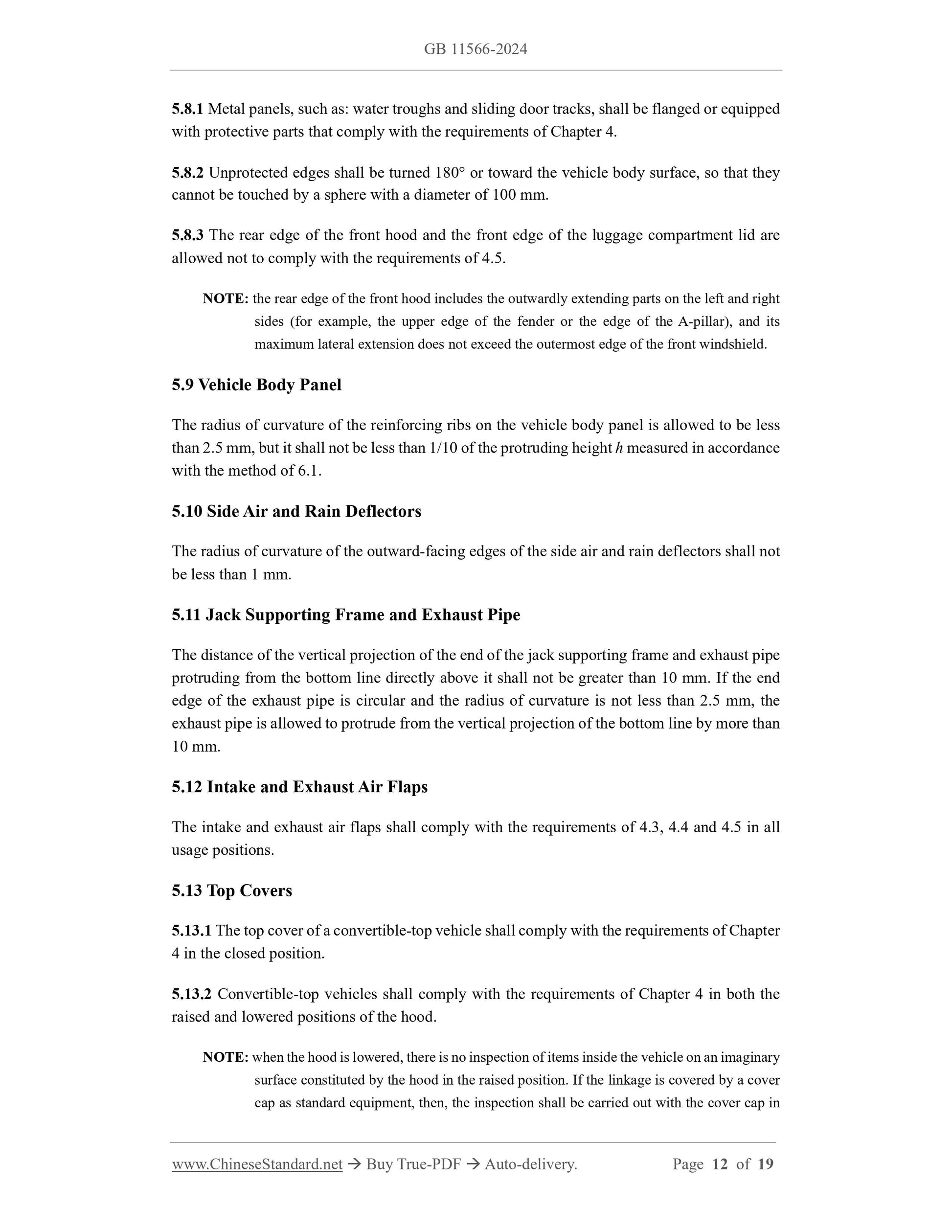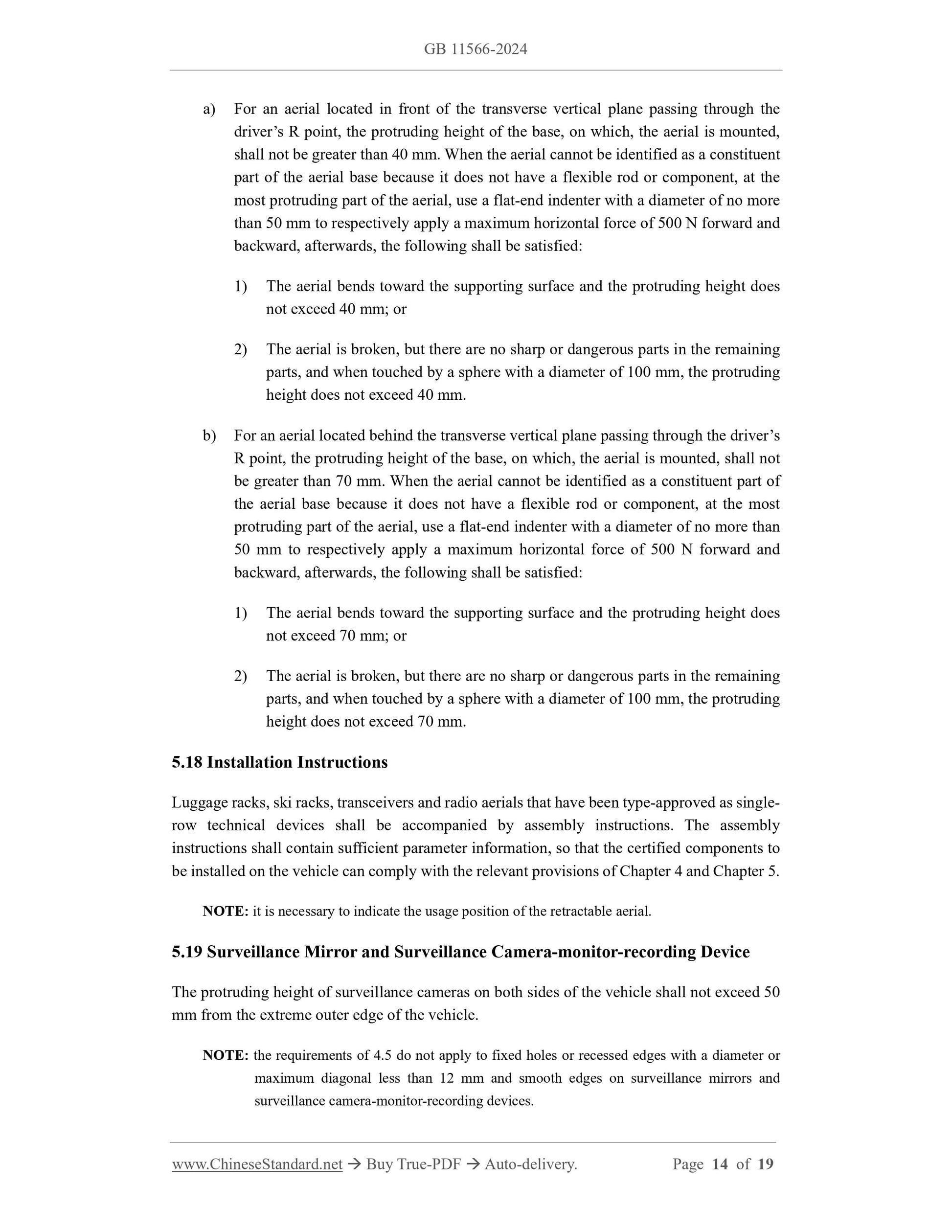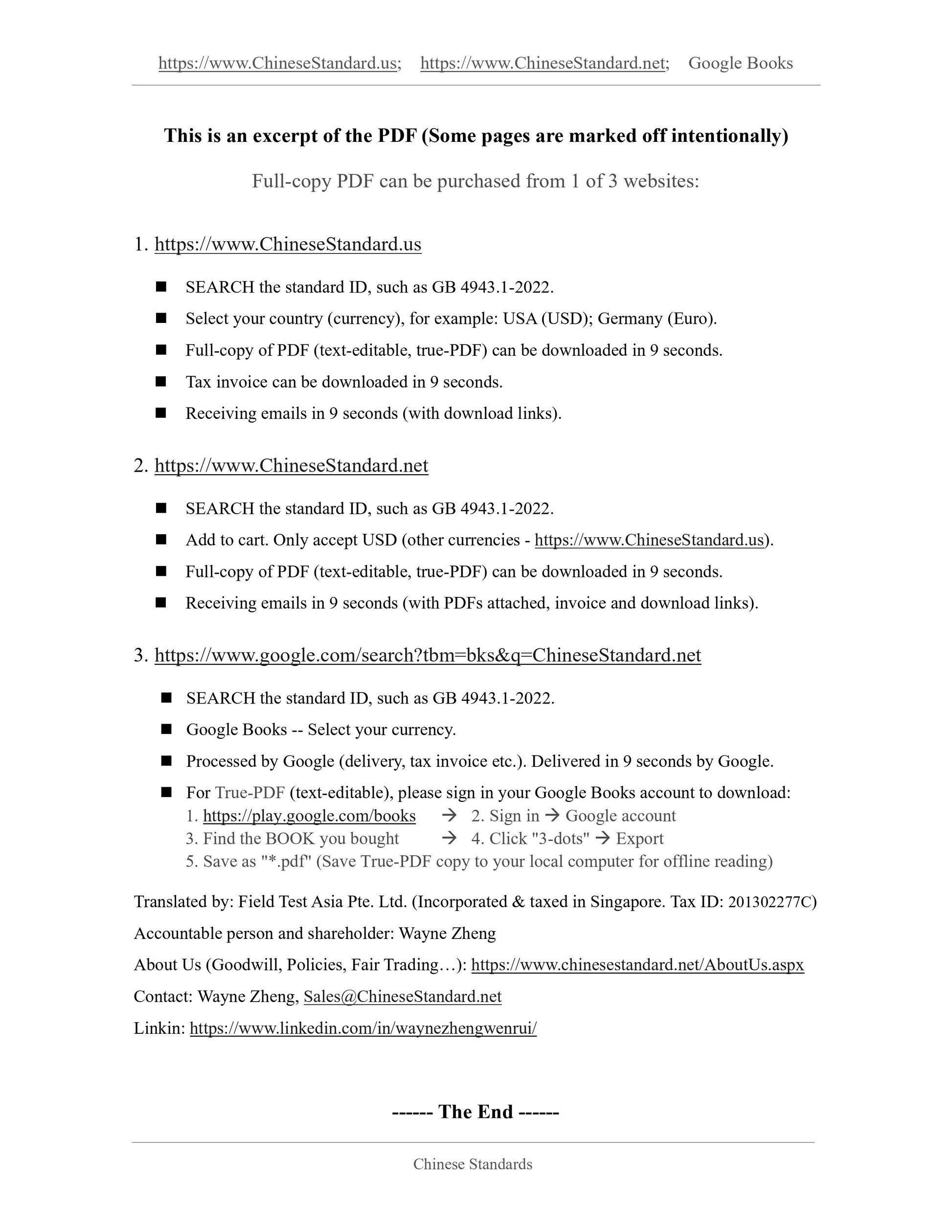1
/
of
10
PayPal, credit cards. Download editable-PDF and invoice in 1 second!
GB 11566-2024 English PDF (GB11566-2024)
GB 11566-2024 English PDF (GB11566-2024)
Regular price
$320.00 USD
Regular price
Sale price
$320.00 USD
Unit price
/
per
Shipping calculated at checkout.
Couldn't load pickup availability
Delivery: 3 seconds. Download true-PDF + Invoice.
Get QUOTATION in 1-minute: Click GB 11566-2024
Historical versions: GB 11566-2024
Preview True-PDF (Reload/Scroll if blank)
GB 11566-2024: External projections for passenger cars
GB 11566-2024
GB
NATIONAL STANDARD OF THE
PEOPLE’S REPUBLIC OF CHINA
ICS 43.040.60
CCS T 26
Replacing GB 11566-2009
External Projections for Passenger Cars
ISSUED ON. AUGUST 23, 2024
IMPLEMENTED ON. JANUARY 1, 2026
Issued by. State Administration for Market Regulation;
Standardization Administration of the People’s Republic of China.
Table of Contents
Foreword... 3
1 Scope... 4
2 Normative References... 4
3 Terms and Definitions... 4
4 General Requirements... 6
5 Special Requirements... 7
6 Test Methods... 15
7 Judgment of the Same Type... 18
8 Implementation of the Standard... 18
External Projections for Passenger Cars
1 Scope
This document specifies the general requirements, special requirements and test methods for
the external projections for Category-M1 vehicles.
This document is applicable to Category-M1 vehicles.
This document does not apply to external indirect vision devices and traction devices.
2 Normative References
The contents of the following documents constitute indispensable clauses of this document
through the normative references in the text. In terms of references with a specified date, only
versions with a specified date are applicable to this document. In terms of references without a
specified date, the latest version (including all the modifications) is applicable to this document.
GB 15084-2022 Motor Vehicles - Devices for Indirect Vision - Requirements of Performance
and Installation
GB/T 15089 Classification of Power-driven Vehicles and Trailers
3 Terms and Definitions
The terms and definitions defined in GB/T 15089, and the following are applicable to this
document.
3.1 front hood
The powertrain hatch and / or luggage compartment lid in front of the windshield.
3.2 external surface
A visible surface on the exterior of a vehicle.
NOTE. it includes front hood, luggage compartment lid, doors, fenders, roof, lighting and light
signaling devices, and visible reinforcing ribs, etc.
3.3 floor line
The geometric trajectory formed by the contact point using a cone with a half angle of 30 and
continuous contact along the lowest position where the external surface of a laden vehicle can
be touched.
NOTE 1.independently determine the height of the cone; based on the principle of ease of
operation, the cone top is upward, and the cone axis is perpendicular to the horizontal
plane.
NOTE 2.when determining the floor line, the lifting points, exhaust pipes or wheels are not
considered. The arched gap on the wheels can be imaged as a continuous smooth surface
formed after filling. When determining the floor line at both ends of the vehicle, the
bumper needs to be considered. For a specific vehicle type, the cone contact point may
be at the end of the bumper or on a vehicle body panel underneath the bumper. If there
are two or more contact points at the same time, take the downmost contact point to
determine the floor line.
3.4 radius of curvature
The radius of the arc of the circle closest to the component.
3.5 laden vehicle
A vehicle loaded to the maximum allowable total mass.
NOTE. if the vehicle is equipped with a hydropneumatics, hydraulic or air suspension device, or
an automatic stabilizing device that changes with the load, load it in accordance with the
most unfavorable conditions specified by the manufacturer under normal driving
conditions.
3.6 extreme outer edge
For both sides of a vehicle, the two planes parallel to the Y plane of the vehicle and tangent to
the outmost edges of both sides of the vehicle; for the front / rear end of a vehicle, a vertical
transverse plane parallel to the X plane of the vehicle and tangent to the front / rear outmost
edges of the vehicle.
NOTE. when determining the extreme outer edge of the vehicle, the following protrusions are not
considered.
---the part where the tire is in contact with the ground and the tire valve;
---anti-skid device mounted on wheels;
---indirect vision device;
---side turn signals, outline marker lamps, front and rear (side) position lights and parking
lights;
---components installed on the front / rear bumper of the vehicle;
following components located on the external surface of the vehicle are applicable to this
document.
---components not higher than 2 m above the ground;
---components not lower than the floor line;
---components that can be touched by a sphere with a diameter of 100 mm.
4.3 There shall be no outward-facing sharp components on the external surface of a vehicle, as
well as outward-facing protrusions that may increase the risk of scratches or bumps, or
aggravate the injuries of the person being hit due to their shapes, dimensions, orientation and
hardness, etc. in a collision accident.
4.4 There shall be no outward-facing components on the external surface of a vehicle that may
scratch pedestrians, cyclists or motorcyclists.
4.5 The radius of curvature of protruding components on the external surface of a vehicle shall
not be less than 2.5 mm.
NOTE 1.this article does not apply to components that protrude the external surface by not more
than 1.5 mm, components that protrude the external surface by more than 1.5 mm, and
components that protrude the external surface by less than 5 mm but with rounded
outward-facing parts.
NOTE 2.this article does not apply to situations where the gap width between fixed elements or
movable elements on the grille (including components of the inlet and outlet of air ducts
and the radiator cover) is less than 40 mm.
4.6 When the hardness of the material of the protruding components on the external surface of
a vehicle does not exceed Shore hardness 60 HA, the radius of curvature is allowed to be less
than 2.5 mm.
5 Special Requirements
5.1 Decorative Parts
5.1.1 For decorative parts that protrude the supporting surface by more than 10 mm, in a plane
parallel to its mounting surface, when applying an external force of 100 N to the highest
protruding point of the decorative part from any direction, the decorative part shall be able to
retract into the supporting surface, fall off or bend and deform. When applying the force of 100
N, a flat-end indenter with a diameter not larger than 50 mm shall be used. After the decorative
part retracts, falls off or bends, the remaining part shall not protrude by a height greater than 10
mm. These protrusions shall, in all cases, comply with the requirements of 4.3.If the decorative
part is installed on a base plate, then, the base plate is considered to be a decorative part and not
the supporting surface. Decorative parts on the grille do not apply to this article, but they shall
comply with the requirements of Chapter 4.
5.1.2 The protective decorative strips or protective parts on the external surface of a vehicle are
not subject to the restrictions of 5.1.1, but they shall be reliably fixed on the vehicle.
5.2 Headlight
5.2.1 When the headlight is equipped with a protruding visor and light ring, the protruding
height of the visor and light ring relative to the outer surface of the headlight lens shall not
exceed 30 mm and the radius of curvature shall not be less than 2.5 mm.
NOTE. this article does not apply to headlight embedded inside or extending on vehicle body
panels.
5.2.2 Retractable headlights shall comply with the requirements of 5.2.1, whether in t...
Get QUOTATION in 1-minute: Click GB 11566-2024
Historical versions: GB 11566-2024
Preview True-PDF (Reload/Scroll if blank)
GB 11566-2024: External projections for passenger cars
GB 11566-2024
GB
NATIONAL STANDARD OF THE
PEOPLE’S REPUBLIC OF CHINA
ICS 43.040.60
CCS T 26
Replacing GB 11566-2009
External Projections for Passenger Cars
ISSUED ON. AUGUST 23, 2024
IMPLEMENTED ON. JANUARY 1, 2026
Issued by. State Administration for Market Regulation;
Standardization Administration of the People’s Republic of China.
Table of Contents
Foreword... 3
1 Scope... 4
2 Normative References... 4
3 Terms and Definitions... 4
4 General Requirements... 6
5 Special Requirements... 7
6 Test Methods... 15
7 Judgment of the Same Type... 18
8 Implementation of the Standard... 18
External Projections for Passenger Cars
1 Scope
This document specifies the general requirements, special requirements and test methods for
the external projections for Category-M1 vehicles.
This document is applicable to Category-M1 vehicles.
This document does not apply to external indirect vision devices and traction devices.
2 Normative References
The contents of the following documents constitute indispensable clauses of this document
through the normative references in the text. In terms of references with a specified date, only
versions with a specified date are applicable to this document. In terms of references without a
specified date, the latest version (including all the modifications) is applicable to this document.
GB 15084-2022 Motor Vehicles - Devices for Indirect Vision - Requirements of Performance
and Installation
GB/T 15089 Classification of Power-driven Vehicles and Trailers
3 Terms and Definitions
The terms and definitions defined in GB/T 15089, and the following are applicable to this
document.
3.1 front hood
The powertrain hatch and / or luggage compartment lid in front of the windshield.
3.2 external surface
A visible surface on the exterior of a vehicle.
NOTE. it includes front hood, luggage compartment lid, doors, fenders, roof, lighting and light
signaling devices, and visible reinforcing ribs, etc.
3.3 floor line
The geometric trajectory formed by the contact point using a cone with a half angle of 30 and
continuous contact along the lowest position where the external surface of a laden vehicle can
be touched.
NOTE 1.independently determine the height of the cone; based on the principle of ease of
operation, the cone top is upward, and the cone axis is perpendicular to the horizontal
plane.
NOTE 2.when determining the floor line, the lifting points, exhaust pipes or wheels are not
considered. The arched gap on the wheels can be imaged as a continuous smooth surface
formed after filling. When determining the floor line at both ends of the vehicle, the
bumper needs to be considered. For a specific vehicle type, the cone contact point may
be at the end of the bumper or on a vehicle body panel underneath the bumper. If there
are two or more contact points at the same time, take the downmost contact point to
determine the floor line.
3.4 radius of curvature
The radius of the arc of the circle closest to the component.
3.5 laden vehicle
A vehicle loaded to the maximum allowable total mass.
NOTE. if the vehicle is equipped with a hydropneumatics, hydraulic or air suspension device, or
an automatic stabilizing device that changes with the load, load it in accordance with the
most unfavorable conditions specified by the manufacturer under normal driving
conditions.
3.6 extreme outer edge
For both sides of a vehicle, the two planes parallel to the Y plane of the vehicle and tangent to
the outmost edges of both sides of the vehicle; for the front / rear end of a vehicle, a vertical
transverse plane parallel to the X plane of the vehicle and tangent to the front / rear outmost
edges of the vehicle.
NOTE. when determining the extreme outer edge of the vehicle, the following protrusions are not
considered.
---the part where the tire is in contact with the ground and the tire valve;
---anti-skid device mounted on wheels;
---indirect vision device;
---side turn signals, outline marker lamps, front and rear (side) position lights and parking
lights;
---components installed on the front / rear bumper of the vehicle;
following components located on the external surface of the vehicle are applicable to this
document.
---components not higher than 2 m above the ground;
---components not lower than the floor line;
---components that can be touched by a sphere with a diameter of 100 mm.
4.3 There shall be no outward-facing sharp components on the external surface of a vehicle, as
well as outward-facing protrusions that may increase the risk of scratches or bumps, or
aggravate the injuries of the person being hit due to their shapes, dimensions, orientation and
hardness, etc. in a collision accident.
4.4 There shall be no outward-facing components on the external surface of a vehicle that may
scratch pedestrians, cyclists or motorcyclists.
4.5 The radius of curvature of protruding components on the external surface of a vehicle shall
not be less than 2.5 mm.
NOTE 1.this article does not apply to components that protrude the external surface by not more
than 1.5 mm, components that protrude the external surface by more than 1.5 mm, and
components that protrude the external surface by less than 5 mm but with rounded
outward-facing parts.
NOTE 2.this article does not apply to situations where the gap width between fixed elements or
movable elements on the grille (including components of the inlet and outlet of air ducts
and the radiator cover) is less than 40 mm.
4.6 When the hardness of the material of the protruding components on the external surface of
a vehicle does not exceed Shore hardness 60 HA, the radius of curvature is allowed to be less
than 2.5 mm.
5 Special Requirements
5.1 Decorative Parts
5.1.1 For decorative parts that protrude the supporting surface by more than 10 mm, in a plane
parallel to its mounting surface, when applying an external force of 100 N to the highest
protruding point of the decorative part from any direction, the decorative part shall be able to
retract into the supporting surface, fall off or bend and deform. When applying the force of 100
N, a flat-end indenter with a diameter not larger than 50 mm shall be used. After the decorative
part retracts, falls off or bends, the remaining part shall not protrude by a height greater than 10
mm. These protrusions shall, in all cases, comply with the requirements of 4.3.If the decorative
part is installed on a base plate, then, the base plate is considered to be a decorative part and not
the supporting surface. Decorative parts on the grille do not apply to this article, but they shall
comply with the requirements of Chapter 4.
5.1.2 The protective decorative strips or protective parts on the external surface of a vehicle are
not subject to the restrictions of 5.1.1, but they shall be reliably fixed on the vehicle.
5.2 Headlight
5.2.1 When the headlight is equipped with a protruding visor and light ring, the protruding
height of the visor and light ring relative to the outer surface of the headlight lens shall not
exceed 30 mm and the radius of curvature shall not be less than 2.5 mm.
NOTE. this article does not apply to headlight embedded inside or extending on vehicle body
panels.
5.2.2 Retractable headlights shall comply with the requirements of 5.2.1, whether in t...
Share
